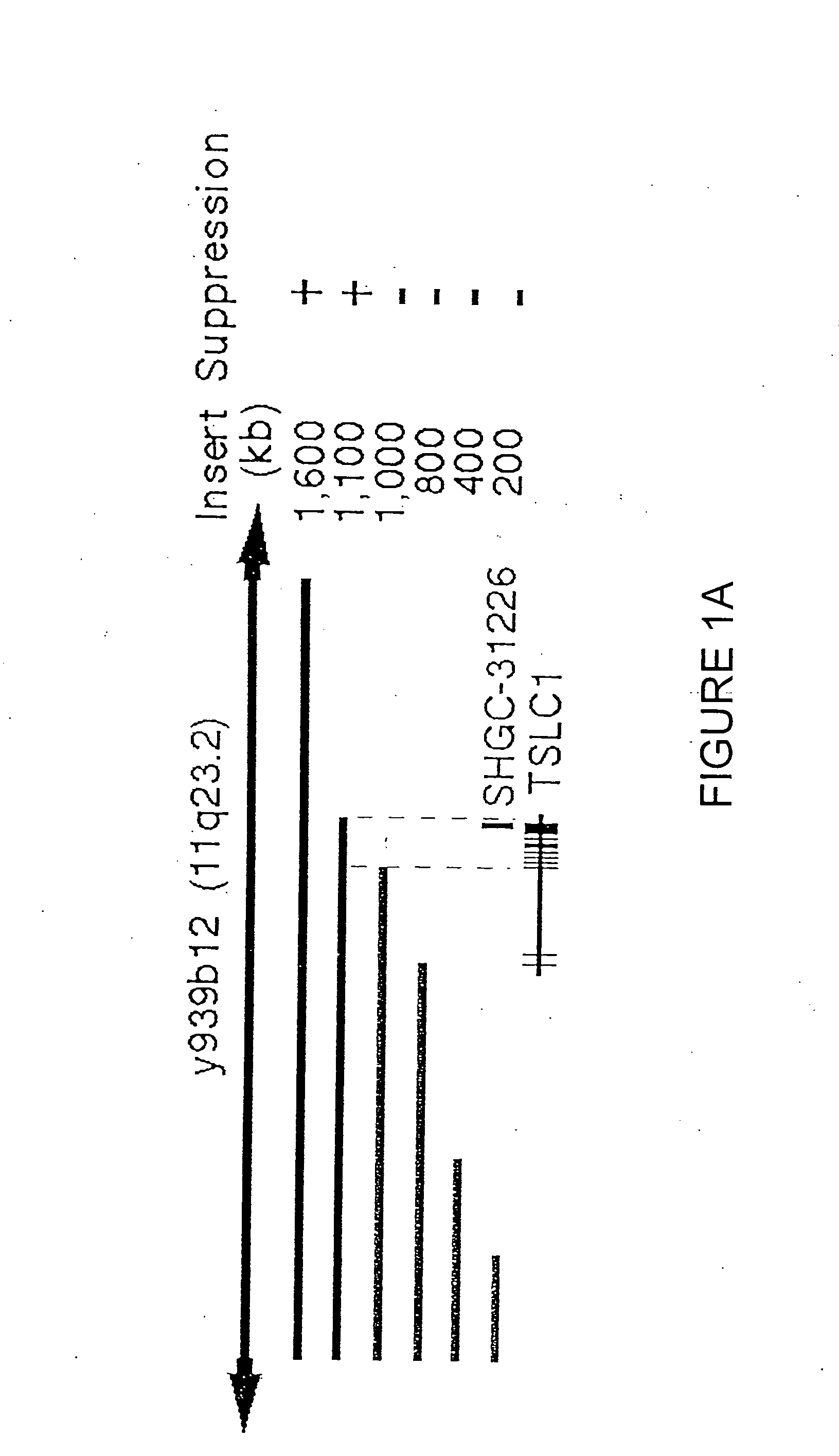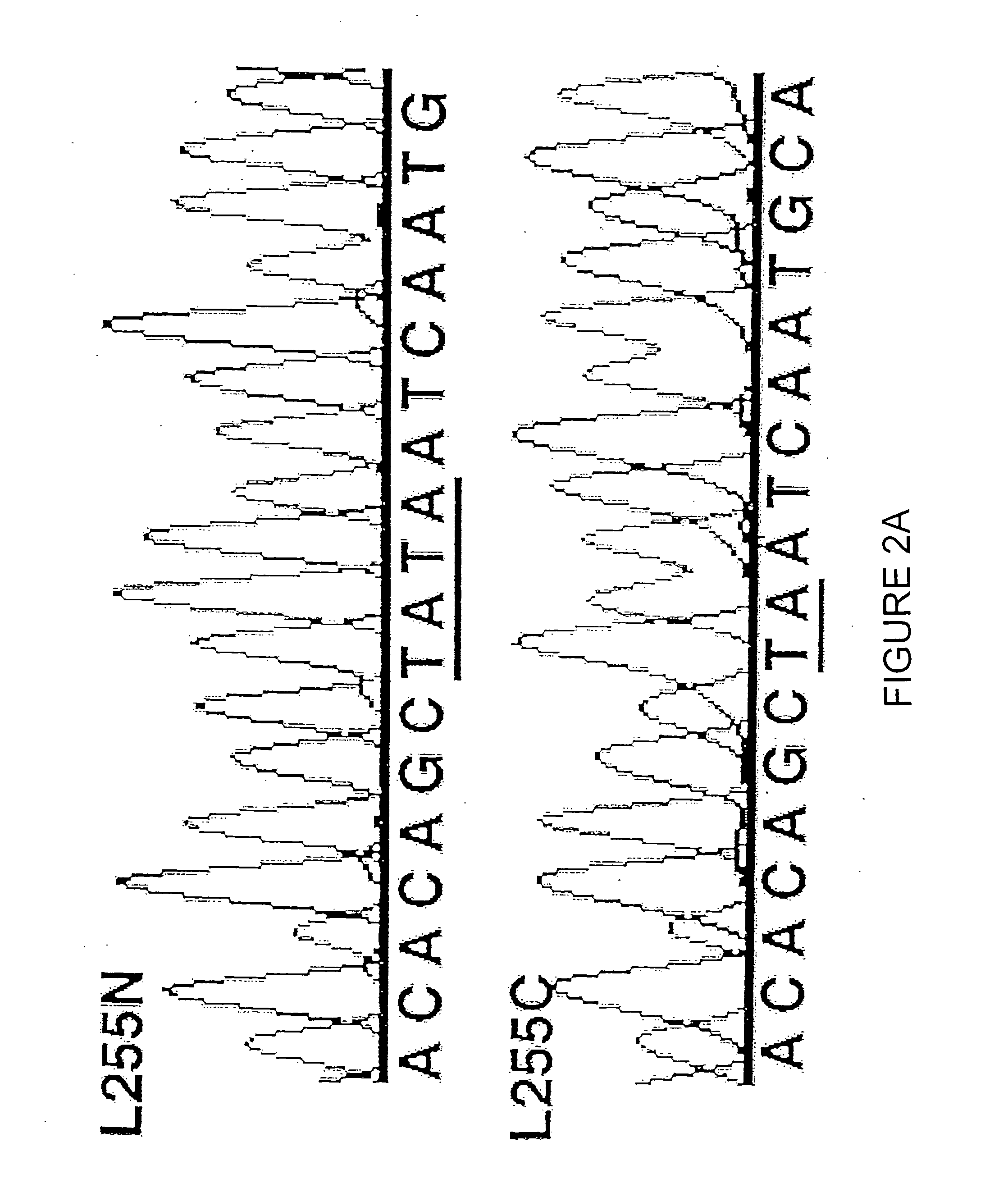Diagnosis and treatment of tumor-suppressor associated disorders
a tumor suppressor and associated disorder technology, applied in the field of molecular medicine, to achieve the effect of reducing the level of tslc1 and suppressing the tumorigenicity of a549
- Summary
- Abstract
- Description
- Claims
- Application Information
AI Technical Summary
Benefits of technology
Problems solved by technology
Method used
Image
Examples
example 1
[0100] Functional mapping of tumor suppressor activity on 11q23.2 was accomplished by introduction of a 1.6 MB YAC and nested deletion derivatives of it into human NSCLS tumor cell line A549. Sixty-seven human ESTs from 11q23 (National Center for Biotechnology Information) were screened for tumor suppressor activity in A549 and an EST clone, SHGC-31226, was mapped within the 100 kb fragment identified on y939b12 (CITB) as responsible for essentially full repression of NSCLS tumor (See FIG. 1A). TSLC1 was localized to a 100 kb segment responsible essential for full suppression. A full-length cDNA was cloned based on cDNA sequencing, overlapping of expressed sequence tag (EST) sequences from the NCBI public database found on the worldwide web at ncbi.nlm.nih.gov / Entrez / , and 5′ rapid amplification of cDNA ends (RACE) using the MARATHONS cDNA Amplification Kit (Clontech) according to the manufacturer's instructions. Olgonucleotide primers used for the first PCR reaction were as follows...
example 2
[0102] The subcellular localization of TSLC1 was examined by expressing a TSLC1:gfp fusion protein in COS 7 cells. A whole or a portion of coding sequences of TSLC1 were amplified by RT-PCR using adult human lung poly-A RNA (Clontech). The following primers used for amplification of TSLC1:
(SEQ ID NO:7)5′-GGGGTACCCAGGTGCCCGACATGGC-3′ and(SEQ ID NO:8)5′-AAGGAAAAAAGCGGCCGCCAGTTGGACACCTCATTGAA-3′>
[0103] The following primers were used for amplification of ΔTSLC1:
(SEQ ID NO: 9)5′-TTGGTACCCGAGCTCGGATCCTCCTGGTCCCACCACGT-3′and(SEQ ID NO: 10)5′-AAGGAAAAAAGCGGCCGCCAGTTGGACACCTCATTGAA-3′
Amplified fragments of TSLC1 and ΔTSLC1 were digested with restriction endonucleases, KpnI and NotI, subcloned into plasmid pcDNA3.1-Hygro (+) (Invitrogen) to yield plasmids pcTSLC1 and pcΔTSLC1, respectively. The inserts of pcTSLC1 and pcΔTSLC1 were then subcloned into plasmid pEGFP-N3 (Clontech), which contains a nucleotide encoding the green fluorescent peptide (gfp) to obtain plasmids pTSLC1-GFP and pΔ...
example 3
[0104] Levels of expression of TSLC1 in tumor cells were determined by measurement of mRNA in A549 cells. Human multiple tissue Northern blot and adult lung poly-A RNA were obtained from Clontech. Poly-A RNA from lung cancer cell lines and their derivatives was extracted using the FASTTRACK® 2.0 kit (Invitrogen). PCR utilizing primers
5′-(SEQ ID NO: 11)CATCACAGTCCTGGTCCCACCACGTAATCT-3′and5′-(SEQ ID NO: 12)AATAGGGCCAGTTGGACACCTCATTGAAAC-3′
was used to derive TSLC1. Intensity of the signals was quantified using the BAS-2000 Imaging System (Fuji).
[0105] Northern Blot analysis of eleven additional human lung adenocarcinoma cell lines (Lane 1, A549; lane 2, ABC-1; lane 3, Calu-3; lane 4, NCI-H441; lane 5 NCI-H522; lane 6, LCMS; lane 7, LCOK; lane 8, VMRC-LCD; lane 9, PC-14; lane 10, SK-LU-1; lane 11, NCI-H596; lane 12, A431; lane 13, normal lung) showed that TSLC1 expression was absent from 4 of the 11 additional cell lines.
[0106] Similar Northern blot analysis found TSLC1 expression ...
PUM
| Property | Measurement | Unit |
|---|---|---|
| concentration | aaaaa | aaaaa |
| pH | aaaaa | aaaaa |
| restriction fragment length polymorphism | aaaaa | aaaaa |
Abstract
Description
Claims
Application Information
 Login to View More
Login to View More - R&D
- Intellectual Property
- Life Sciences
- Materials
- Tech Scout
- Unparalleled Data Quality
- Higher Quality Content
- 60% Fewer Hallucinations
Browse by: Latest US Patents, China's latest patents, Technical Efficacy Thesaurus, Application Domain, Technology Topic, Popular Technical Reports.
© 2025 PatSnap. All rights reserved.Legal|Privacy policy|Modern Slavery Act Transparency Statement|Sitemap|About US| Contact US: help@patsnap.com



